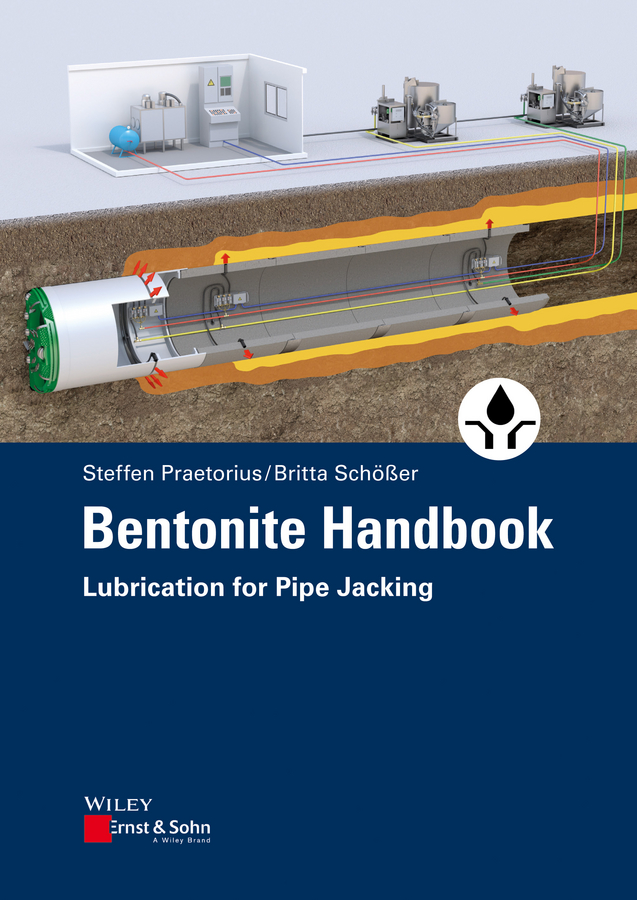
Bentonite Handbook: Lubrication for Pipe Jacking
Praetorius, Steffen
Schößer, Britta
Pipe jacking is a construction process for the no–dig laying of pipes. Successful pipe jacking demands low skin friction between the ground and the jacked pipe. This is achieved with bentonite lubrication. The bentonite slurry fed into the annular gap fulfils several purposes. It stabilises the annular gap by supporting the surrounding ground and reduces friction contact between ground and jacked pipe. The Bentonite Handbook deals comprehensibly with the relevant aspects of annular gap lubrication: starting with the ground conditions, which are of decisive importance for lubrication, through the rheological properties of the bentonite slurry to the technical components of lubrication technology and lubrication strategy. The use of standardised measuring apparatus is described as well as mixing equipment and the automatic lubrication system. Overview tables with calculations and suggested values for bentonite consumption quantities depending on the prevailing ground conditions and the pipe jacking parameters complete the recommendations. INDICE: Acknowledgement VII .Foreword IX .List of symbols used XV .I. Greek symbols XV .II. Latin symbols XV .1 Basics 1 .1.1 Basics and technical implementation of bentonite lubrication systems 1 .1.2 Annular gap lubrication in pipe jacking 5 .1.3 Preliminary remarks about the ground 6 .2 Bentonite and bentonite suspensions 9 .2.1 Composition and structure 9 .2.2 Hydration behaviour 10 .2.3 Card house structure and thixotropy 11 .2.4 Yield point, viscosity and gel strength 12 .2.5 Stability 17 .2.6 Usual types of bentonite 19 .3 Additives 21 .3.1 Polymers 21 .3.2 Types of polymer additives 24 .3.3 Overview of polymer additives and their functions 27 .4 Correct preparation of bentonite suspensions 29 .4.1 Mixing 29 .4.2 Mixing equipment 33 .4.3 Mixing instructions 34 .4.4 Hydration tank 35 .5 Properties of the suspension and measurement processes 37 .5.1 Viscosity: Marsh funnel 37 .5.2 Yield point: ball–harp rheometer 40 .5.3 Viscosity and gel strength: Rotational viscometer 42 .5.4 Filtrate water and thickness of filter cake: filter press 43 .5.5 Density 45 .5.6 Water hardness: test strips 46 .5.7 pH value 46 .5.8 Conductivity 46 .5.9 Temperature 47 .6 Ground and groundwater 49 .6.1 Geology of solid rock 49 .6.2 Geology of soils 65 .6.3 Stability and stand–up time 85 .6.4 Hydrogeology 88 .6.5 Influence of various rock properties on the use of bentonite 99 .6.6 Contamination in the ground, groundwater or mixing water 100 .7 Bentonite suspensions for annular gap lubrication 105 .7.1 Size of the annular gap 105 .7.2 Vertical position of the pipe string in the driven cavity 107 .7.3 Functions of the lubricant in the annular gap 111 .7.4 Adaptation of the bentonite suspension to the ground 119 .7.5 Rheological parameters of the bentonite suspension 124 .7.6 Suspension quantities 132 .7.7 Time–dependant loss volumes 147 .7.8 Lubrication strategies 148 .8 Lubrication technology 155 .8.1 Arrangement and spacing of the lubrication points in the pipe string 155 .8.2 Number and arrangement of the injection fittings per lubricating point in the pipe cross–section 156 .8.3 Non–return valves 157 .8.4 Lubrication circuit 158 .8.5 Interaction between the support pressure at the face and the annular gap pressure 159 .8.6 Bentonite supply in the starting area 160 .8.7 Lubricant pressure, lubricant quantity and pressure losses 161 .9 Reporting 163 .9.1 Which parameters should be documented for bentonite lubrication? 163 .9.2 Forms 163 .10 Lists of the required injection quantities 167 .10.1 Explanation of the lists 167 .Literature 197
- ISBN: 978-3-433-03137-7
- Editorial: Wiley VCH
- Encuadernacion: Rústica
- Páginas: 228
- Fecha Publicación: 22/02/2017
- Nº Volúmenes: 1
- Idioma: Inglés
